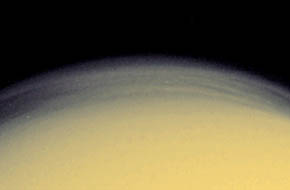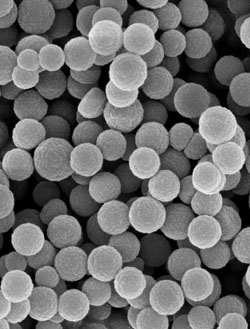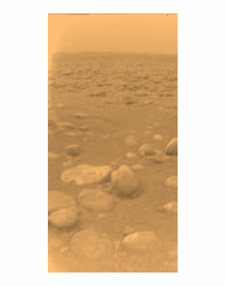This year's meeting of the American Astronomical Society's Division for Planetary Sciences has drawn more than 900 researchers to Pasadena, California, home of Caltech and NASA's Jet Propulsion Laboratory. This place is also well known for the smutty haze that chokes the sky above the greater Los Angeles Basin all too often. Urban smog is a byproduct of millions of cars pumping nitrogen oxides and other gases into the lower atmosphere, where sunlight converts them into tiny aerosol particles.

The dense, nitrogen-dominated atmosphere of Titan is laced with multiple layers of organic haze that shroud the surface from view. This false-color view shows the north polar region as it appeared on October 24, 2004.
Courtesy NASA/JPL/Space Science Institute.
One of yesterday's scientific presentations focused on another world cloaked in dense smog: Saturn's big moon Titan. It's the only other solar-system body, apart from Earth, with a nitrogen-dominated atmosphere. Titan's air also contains a few percent methane (CH4), and even though sunlight out there is weak, it's still strong enough to turn these two gases into opaque aerosol layers that obscure the moon's surface from view.
Cosmic chemists have long thought that Titan's haze is mostly ethane (C2H6), which should constantly drizzle out of the sky once the droplets grow large enough. In fact, they're still trying to figure out why the Huygens probe landed with a thump — and not a splash — when it touched down on Titan's surface in January 2005.
Alchemically speaking, there's only so much you can cook up with just nitrogen and methane. But now researchers realize the Titanian mix contains a little oxygen, discovered in October 2004 when the Cassini spacecraft passed close enough to get a whiff of the gases being stripped off the moon's upper atmosphere by charged particles in Saturn's magnetosphere.
Oxygen is a game-changer, because it contributes to an even more complex photochemistry. The problem is that, while Cassini scientists can tell that Titan's high-altitude haze contains some very complex organic compounds, the spacecraft's instruments lack the sophistication to reveal what they are.

An electron microscope reveals microscopic spheres of complex organic compounds, called tholins, created during a laboratory simulation of conditions in the uppermost atmosphere of Titan.
Edith Hadamuck / UPMC / Univ. of Paris
As I learned yesterday, we now have exciting compositional clues. Sarah Hörst, a University of Arizona graduate student, recently led an international team that recreated the conditions high above Titan in a French laboratory, by pumping microwave energy into a low-pressure mix of nitrogen, methane, and oxygen. The result was a haze of tiny hydrocarbon particles no bigger than 0.1 micron across, a good match to the aerosol sizes found floating over Titan.
When Hörst and her team analyzed the experiment's byproducts, they discovered a trove of organic molecules critical to the existence of life. Among them were adenine, cytosine, guanine, thymine, and uracil — the five key nucleotide compounds found in DNA and RNA — along with a dozen amino acids.
"Finding all five nucleotide bases was terrifying," she says. "It was as if someone had sneezed in the test tube." But careful checks prove that these compounds were synthesized in the experiment, rather than being contaminants from inhabitants of Planet Earth.
Not much oxygen is needed — add too much to the mix, Hörst cautions, and the resulting chemicals end up combusting with each other. The source of Titan's oxygen is likely Enceladus, whose effervescent plumes continually spew water vapor into the Saturnian system. Once exposed to space, radiation breaks the water down into hydrogen and oxygen ions. Interestingly, Hörst points out, the oxygen entering Titan's atmosphere is just the right amount to drive the synthesis of prebiotic compounds.
Hörst's simulations aren't the first to try to cook up a prebiotic brew from simple gases, though they're the first to include oxygen. Her results hark back to the granddaddy of all such experiments, conducted in 1952 by Stanley Miller and Harold Urey, that famously synthesized amino acids from methane, ammonia (NH3), hydrogen, and water. Also, Bishun Khare (SETI Institute) continues the lab experiments he began with the late Carl Sagan to create complex prebiotic compounds, which they dubbed "tholins."

Titan's surface looks orange in full-color images. This shot, taken after the Huygens probe touched down on January 14, 2005, shows possible methane or ethane ground fog, The largest "rock" in the middle of the image is really only 6 inches (15 cm) across. Spectra suggest that the ground under the probe contains a mixture of water and hydrocarbon ice.
A key realization is that these chemical reactions are occurring at the highest levels in Titan's atmosphere, hundreds of miles above the visible haze layers. According to Yuk Yung (Jet Propulsion Laboratory), tholins are being created at least 600 miles (1,000 km) above Titan — a finding made by using Cassini's ultraviolet-visible spectrometer to monitor how starlight changes as it passes through the moon's upper atmosphere. "It is clear that tholins form at high altitude in the ionosphere, and then precipitate downward," Yung notes, though they aren't as abundant over the polar regions.
It's not yet clear whether the prebiotic compounds are forming around Titan or are being deposited there by the micrometeorites that constantly rain down on it. But that's not the point. “We can do this entirely in an atmosphere,” Hörst said. “We don’t need liquid water, we don’t need a surface." By implication is that the building blocks of life can form in a planet's upper atmospheres — conceivably even Earth's, long ago.
Regardless, the new work shows that there's a lot going on in Titan's atmosphere — adding even more impetus for NASA to send a dedicated spacecraft its way.
 1
1
Comments
Michael C. Emmert
October 12, 2010 at 4:49 pm
This is a very interesting article; obviously the main conclusion is that the Huygens experiment needs to be repeated. I don't know how the gizmo to collect tiny particles at 1000 km would be designed. Results here say that's important. The old idea of a balloon though not dead can't be used at such high altitudes.
At the low temperatures of Titan, the traditional DNA segments react too slowly to be the basis of life. But we still haven't thoroughly explored acetylene based life, or some other compound yet unknown. Though chances of finding life there are very low, the importance of the results is so great that a strong gamble is justified.
You must be logged in to post a comment.
You must be logged in to post a comment.